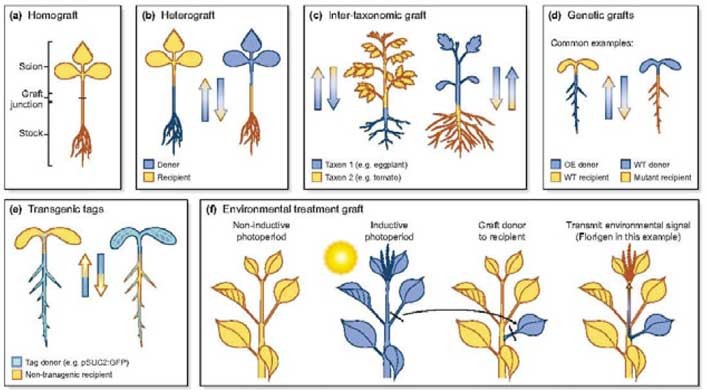博文
New Phytologist:植物嫁接综述
||
Connecting the pieces: uncovering the molecular basis for long‐distance communication through plant grafting
First author: Hannah R. Thomas; Affiliations: Cornell University (康奈尔大学): Ithaca, USA
Corresponding author: Margaret H. Frank
Vascular plants are wired with a remarkable long‐distance communication system. This network can span from as little as a few centimeters (or less) in species like Arabidopsis, up to 100 m in the tallest giant sequoia, linking distant organ systems into a unified, multicellular organism. Grafting is a fundamental technique that allows researchers to physically break apart and reassemble the long‐distance transport system, enabling the discovery of molecular signals that underlie intra‐organismal communication. In this review, we highlight how plant grafting has facilitated the discovery of new long‐distance signaling molecules that function in coordinating developmental transitions, abiotic and biotic responses, and cross‐species interactions. This rapidly expanding area of research, offers sustainable approaches for improving plant performance in the lab, the field, the orchard, and beyond.
维管植物具有非常独特的长距离通讯系统。该网络在不同物种中的尺度差异巨大,从拟南芥中的几厘米到红杉中的数百米,这些网络连接着植物不同部位的器官形成一个整体的、多细胞生物。嫁接是一种十分重要的技术,研究人员可以将植物打断,然后再重组长距离运输系统,进而可以研究植物不同器官间通讯的分子信号。本文中,作者综述了植物嫁接是如何用于鉴定植物长距离信号分子的发现的,这些信号分子作用于植物的发育状态转变、生物和非生物胁迫响应以及不同物种间的互作。该领域的快速发展为试验、大田、果园等植物的表型改良提供了一个可持续的方法。
通讯:Margaret H. Frank (https://www.franklab-cornell.org)
个人简介:2003-2007年,巴纳德学院,生物学学士;2008-2014年,康奈尔大学,植物生物学博士。
研究方向:植物嫁接。
doi: https://doi.org/10.1111/nph.15772
Journal: New Phytologist
First Published: March 04, 2019
https://blog.sciencenet.cn/blog-3158122-1166947.html
上一篇:Development:形成层单层干细胞决定植物的径向生长
下一篇:Nature Plants:植物精细胞特异性表达DUF679膜蛋白助力配子融合
全部作者的其他最新博文
- • Plant Physiology:CsMADS3促进柑果中的叶绿素降解和类胡萝卜素合成(华中农业大学)
- • Molecular Plant:LBD11-ROS反馈调节作用于拟南芥的维管形成层增殖和次生生长(浦项科技大学)
- • Science Advances:根结线虫通过调控植物的CLE3-CLV1模块,促进侵染进程(日本熊本大学)
- • Nature Communications:油菜素内酯参与植物营养生长期转变的分子机制解析(浙江农林大学)
- • Current Biology:光合作用产生的蔗糖驱动侧根“生物钟”(德国弗莱堡大学)
- • PNAS:花同源异型基因在叶中被抑制、花中被激活的分子机制(南卡罗来纳大学)

